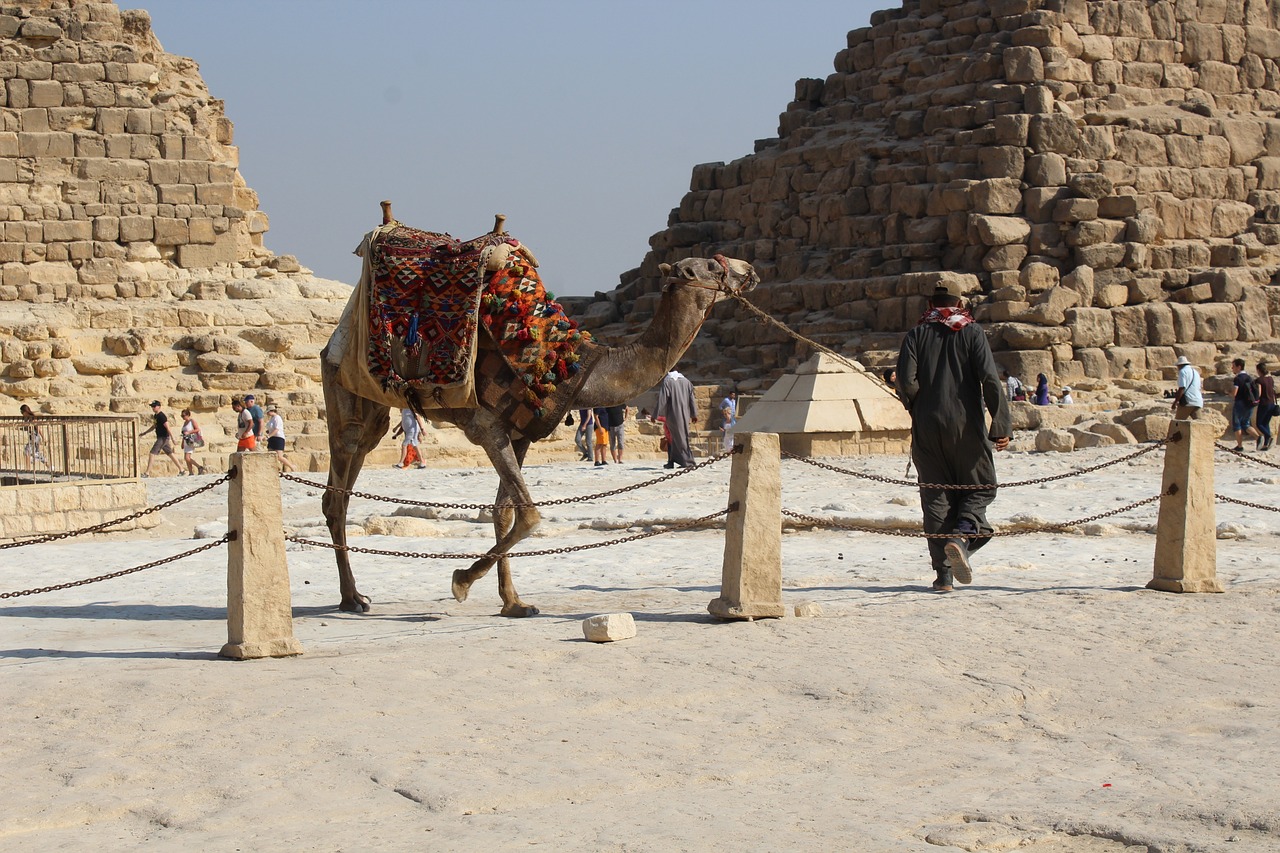The Mystery of the Ancient Egyptian Labor Force
The ancient Egyptian civilization has always captivated historians and archeologists with its grandeur and mystique. One of the most intriguing aspects of this ancient society is the labor force that built and sustained it. From constructing monumental pyramids to tending to fertile farmlands along the Nile River, the labor force of ancient Egypt played a crucial role in shaping the civilization we marvel at today.

Construction Projects
Exploring the labor force involved in building the pyramids and other monumental structures in ancient Egypt, particularly in the realm of construction projects, unveils a fascinating narrative of innovation, dedication, and sheer human effort. The construction projects of ancient Egypt stand as a testament to the remarkable capabilities of the labor force that meticulously crafted these awe-inspiring structures.
When delving into the construction projects of ancient Egypt, one cannot help but marvel at the sheer scale and precision with which these monumental structures were built. The labor force responsible for these endeavors exhibited unparalleled craftsmanship and ingenuity, utilizing rudimentary tools and unparalleled expertise to erect the pyramids and temples that continue to captivate the world.

Agricultural Labor
In ancient Egypt, agricultural labor was a cornerstone of the civilization's prosperity. The fertile lands along the Nile River provided the perfect environment for cultivation, and laborers played a crucial role in ensuring a bountiful harvest. Farmers, both men and women, toiled under the scorching sun, utilizing simple tools like hoes and plows to tend to the fields. The annual flooding of the Nile brought nutrient-rich silt, which made the soil fertile and ideal for growing crops such as wheat, barley, and flax.
One of the key aspects of agricultural labor in ancient Egypt was the meticulous planning and organization of farming activities. Farmers followed a strict calendar based on the flooding of the Nile, dividing the year into three seasons: Akhet (inundation), Peret (growth), and Shemu (harvest). Each season required specific tasks, from preparing the fields and sowing seeds to harvesting the crops. The labor force worked in unison, guided by the knowledge passed down through generations, ensuring the success of each agricultural cycle.
Women also played a significant role in agricultural labor, actively participating in planting, weeding, and harvesting alongside men. They were integral to the agricultural workforce, contributing their skills and expertise to ensure the productivity of the fields. Women were often responsible for tasks such as processing grain, spinning flax into linen, and managing household gardens, showcasing their diverse roles in sustaining the agricultural economy of ancient Egypt.
The agricultural labor force in ancient Egypt was not only essential for providing sustenance to the population but also for supporting the economy and the overall prosperity of the civilization. The success of farming practices relied heavily on the hard work and dedication of laborers, who worked tirelessly to ensure a stable food supply and economic stability. Their efforts in cultivating the land and harnessing the resources of the Nile River were fundamental to the flourishing of ancient Egyptian society.

Artisans and Craftsmen
Artisans and craftsmen in ancient Egypt were the masterminds behind the intricate artifacts and tombs that continue to mesmerize the world today. These skilled workers possessed a level of craftsmanship that was unparalleled in their time, creating pieces that reflected the rich cultural and artistic heritage of Egypt.
Working with precision and dedication, artisans and craftsmen honed their skills over years of practice, passing down their knowledge from generation to generation. Their expertise extended to a wide range of materials, including precious metals, stones, wood, and pottery, allowing them to create a diverse array of objects that served both practical and symbolic purposes.
One of the most famous groups of artisans in ancient Egypt were the tomb builders responsible for constructing the elaborate burial chambers for the pharaohs and nobility. These craftsmen not only built the physical structures but also adorned them with intricate carvings, paintings, and hieroglyphics that told the stories of the deceased and ensured their safe passage to the afterlife.
Artisans and craftsmen were highly respected in ancient Egyptian society, with their work being considered a form of divine creation. They were often employed by the royal court or temples, where they worked on prestigious projects that showcased their exceptional talents. Their creations were not only objects of beauty but also held significant religious and spiritual importance, serving as links between the earthly realm and the divine.
Through their artistry and craftsmanship, artisans and craftsmen played a crucial role in shaping the cultural identity of ancient Egypt. Their creations continue to be studied and admired today, offering valuable insights into the beliefs, practices, and daily life of this fascinating civilization.

Slavery in Ancient Egypt
Slavery in ancient Egypt has long been a topic of debate and controversy among historians and scholars. While the extent of slavery's role in ancient Egyptian society is still a subject of research and discussion, there is evidence to suggest that slavery did exist in various forms during this time period.
Slaves in ancient Egypt were typically prisoners of war, criminals, or individuals who had fallen into debt bondage. They were considered the property of their owners and could be bought, sold, or inherited. Slaves were employed in various sectors of society, including agriculture, construction, and domestic service.
Despite being enslaved, some individuals were able to rise to positions of power and influence within Egyptian society. For example, some slaves were able to earn their freedom through loyal service or exceptional skills, while others were granted freedom upon the death of their owners.
It is important to note that the treatment of slaves in ancient Egypt varied depending on their roles and the attitudes of their owners. Some slaves were well-treated and integrated into their owners' households, while others faced harsh conditions and mistreatment.
While slavery undoubtedly played a role in the economy and labor force of ancient Egypt, it is essential to consider the complexities and nuances of this institution within the broader context of Egyptian society. Further research and archaeological discoveries continue to shed light on the lives and experiences of slaves in ancient Egypt, adding to our understanding of this fascinating civilization.

Tools and Technology
Have you ever wondered about the incredible feats of labor that went into constructing the magnificent pyramids and temples of ancient Egypt? The labor force of this ancient civilization played a crucial role in shaping the monumental structures we marvel at today. Let's delve into the various aspects of the ancient Egyptian labor force and uncover the mysteries surrounding their tools, techniques, and organization.
When it comes to the tools and technology used by the ancient Egyptian labor force, one cannot help but be amazed by their ingenuity and craftsmanship. From the construction of the pyramids to the intricate artifacts created by skilled craftsmen, the tools they utilized were essential to their work.
The ancient Egyptians employed a variety of tools in their labor activities, ranging from simple hand tools like chisels, hammers, and saws to more specialized instruments such as copper drills and adzes. These tools were crucial in shaping stones for construction, carving hieroglyphics, and crafting intricate jewelry and pottery.
Moreover, the technology used by the labor force extended beyond just tools. The Egyptians were pioneers in irrigation techniques, utilizing the annual flooding of the Nile River to cultivate crops efficiently. Their knowledge of agricultural practices and water management was unparalleled in the ancient world.
Additionally, the construction of monumental structures like the pyramids required advanced engineering skills and precise measurement tools. The use of leveling instruments, ramps, and pulleys showcases the sophistication of their technology and the meticulous planning that went into these grand projects.
Overall, the tools and technology employed by the ancient Egyptian labor force were not only practical but also symbolic of their advanced civilization and innovative spirit.

Organization of Labor
In ancient Egypt, the organization of labor was a complex and structured system that played a crucial role in the construction of monumental structures, agricultural practices, and artisanal work. The workforce was divided into different categories based on skills, expertise, and social status, creating a hierarchical structure that governed the labor force's activities. At the top of the hierarchy were skilled craftsmen and overseers who supervised and coordinated the laborers' tasks, ensuring efficiency and quality in the projects undertaken.
Within this organized system, laborers were assigned specific roles and responsibilities based on their capabilities and training. Workers were grouped into teams led by experienced individuals who provided guidance and direction to ensure the successful completion of various projects. The division of labor allowed for specialization, with each worker focusing on a particular aspect of the task at hand, whether it be quarrying stones for construction, sowing and harvesting crops, or creating intricate artifacts.
Moreover, the organization of labor in ancient Egypt was closely tied to the religious beliefs and practices of the society. Workers often performed their tasks in alignment with religious rituals and ceremonies, believing that their work was a form of devotion to the gods. This spiritual connection infused their labor with a sense of purpose and significance, driving them to excel in their craft and contribute to the greater glory of the civilization.
The labor force in ancient Egypt also had a strong sense of community and camaraderie, with workers supporting and assisting each other in their daily tasks. Teamwork was essential in achieving collective goals, whether it was constructing a pyramid, tending to agricultural fields, or creating elaborate tombs for the pharaohs. This sense of unity and collaboration fostered a sense of pride and accomplishment among the laborers, strengthening their bond and commitment to their work.
Overall, the organization of labor in ancient Egypt was a sophisticated system that integrated skilled craftsmanship, hierarchical structure, religious beliefs, and communal spirit. This intricate network of laborers and artisans formed the backbone of Egyptian society, driving its development, innovation, and cultural achievements. The legacy of their organized labor continues to fascinate and inspire us today, shedding light on the remarkable capabilities and ingenuity of the ancient Egyptian workforce.

Role of Women in Labor
Women played a significant role in various labor sectors in ancient Egyptian society, contributing to the workforce in diverse capacities. While men often dominated physical labor and construction projects, women were actively involved in agricultural labor, particularly in tasks related to planting, harvesting, and processing crops along the fertile banks of the Nile River. Their expertise in agricultural practices was crucial for ensuring a steady food supply and sustaining the economy of ancient Egypt.
Moreover, women also participated as artisans and craftswomen, showcasing their skills in pottery-making, weaving, and other intricate crafts. They were responsible for creating beautiful artifacts and textiles that were highly prized in ancient Egyptian society. These skilled women played a vital role in preserving the cultural heritage and artistic legacy of the civilization through their craftsmanship and dedication to their craft.
Despite the prevailing patriarchal structure of ancient Egyptian society, some women held positions of authority and leadership in labor organizations. They managed workshops, supervised laborers, and made important decisions regarding production and distribution. These women demonstrated exceptional managerial skills and business acumen, challenging traditional gender roles and stereotypes in the workforce.
Furthermore, in the realm of religious practices, women also played essential roles in performing sacred rituals and ceremonies associated with labor activities. Their spiritual devotion and connection to deities influenced the labor force's morale and productivity, fostering a sense of unity and purpose among workers. Women acted as intermediaries between the divine realm and the earthly domain, ensuring the favor of gods and goddesses upon labor endeavors.
Overall, the role of women in labor in ancient Egypt was multifaceted and integral to the functioning of society. Their contributions spanned across various sectors, from agriculture to craftsmanship, from management to religious practices. Women's labor was not only essential for the economic prosperity of the civilization but also for the cultural and spiritual enrichment of ancient Egyptian life.

Religious Beliefs and Labor
Throughout ancient Egyptian history, the labor force played a crucial role in shaping the civilization's monumental structures, agricultural practices, and artistic endeavors. Let's delve into the intricate web of laborers who toiled under the scorching sun of the Nile Valley, driven by a combination of religious beliefs, economic imperatives, and societal structures.
Religion permeated every aspect of ancient Egyptian life, including the realm of labor. The belief in an afterlife and the importance of proper burial rituals led to the creation of elaborate tombs and funerary objects. Laborers, from skilled artisans to agricultural workers, were motivated by the promise of a prosperous afterlife for themselves and their loved ones. The construction of temples and pyramids was not merely a physical task but a spiritual endeavor, with workers viewing their efforts as offerings to the gods.

Economic Impact of Labor
When we delve into the economic impact of labor in ancient Egypt, we uncover a complex web of factors that shaped the society's financial landscape. The labor force, comprising a diverse range of workers from farmers to artisans, played a crucial role in driving the economy forward. Their contributions were not only limited to the physical labor they provided but also extended to the production of goods and services that sustained the civilization.
One of the key economic impacts of labor in ancient Egypt was the creation of monumental structures like the pyramids. These awe-inspiring constructions not only served religious and cultural purposes but also attracted trade and tourism, bringing wealth to the region. The skilled laborers involved in these projects were highly valued for their expertise, contributing to the prestige and economic prosperity of the society.
Moreover, the agricultural labor force played a vital role in ensuring food security and surplus production along the fertile banks of the Nile River. The abundance of crops not only sustained the local population but also enabled trade with neighboring regions, establishing Egypt as a prosperous hub of commerce in the ancient world.
When we consider the economic implications of labor in ancient Egypt, it becomes evident that the workforce was intricately linked to the overall financial stability of the civilization. The organization of labor, the utilization of advanced tools and technology, and the division of tasks among different sectors all contributed to a thriving economy that stood the test of time.
Furthermore, the economic impact of labor extended beyond the material realm and intersected with religious beliefs and practices. The labor force's dedication to their work, guided by spiritual motivations, infused a sense of purpose and divine significance into their daily activities, shaping the economic landscape through a lens of cultural and religious significance.
In conclusion, the economic impact of labor in ancient Egypt was multifaceted, influencing not only the financial prosperity of the society but also its cultural, religious, and social fabric. The labor force's contributions reverberated through the ages, leaving a lasting legacy of innovation, craftsmanship, and economic resilience that continues to captivate and inspire us today.
Frequently Asked Questions
- What were the main construction projects that the ancient Egyptian labor force worked on?
The ancient Egyptian labor force was primarily involved in building monumental structures such as the pyramids, temples, and tombs for pharaohs and nobility.
- Did women play a significant role in labor activities in ancient Egypt?
Yes, women in ancient Egypt were actively involved in various labor sectors such as agriculture, weaving, pottery making, and even construction work alongside men.
- How were laborers organized within the workforce of ancient Egypt?
Laborers in ancient Egypt were organized in a hierarchical structure, with overseers supervising the work and ensuring tasks were carried out efficiently.
- What tools and technology did the ancient Egyptian labor force use?
The labor force in ancient Egypt utilized tools such as copper chisels, wooden mallets, and simple machines like levers and pulleys to aid in construction, agriculture, and other tasks.
- Were slaves a common part of the labor force in ancient Egypt?
Slavery was present in ancient Egypt, but the extent to which it played a role in the labor force is still debated among historians and scholars.



















